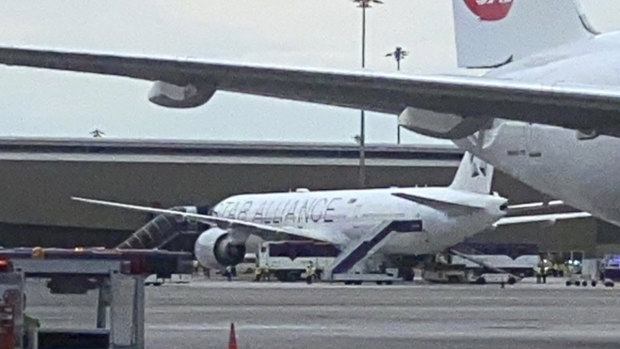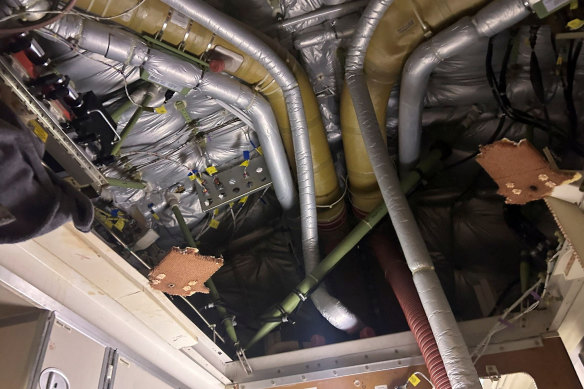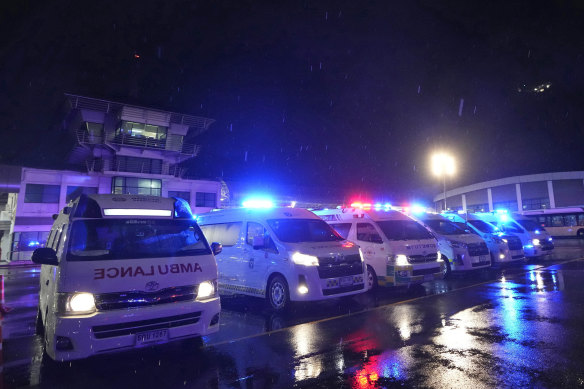By Chayut Setboonsarng and Panu Wongcha-um
One passenger has died and more than 70 others were injured, including eight Australians, after a Singapore Airlines flight hit severe turbulence on Tuesday, flinging passengers and crew around the cabin and forcing the plane to land in Bangkok, officials and the airline said.
Flight SQ321, from London to Singapore, fell into an air pocket while the cabin crew were serving breakfast before it encountered turbulence, prompting the pilots to request an emergency landing, Bangkok Suvarnabhumi Airport, general manager Kittipong Kittikachorn told a press conference.
The sudden turbulence occurred over the Irrawaddy Basin in Myanmar about 10 hours into the flight, the airline said. The pilot declared a medical emergency and diverted the aircraft – a Boeing 777-300ER – to Bangkok, it said without giving further details.
After hitting the severe turbulence, the plane descended about 6000 feet in just a few minutes.
Flight data provided by FlightRadar24 showed the plane at 37,000 feet in the air at 8.06am (co-ordinated universal time). At 8.11am, the plane dropped to 31,000 feet.
A 73-year-old British man died during the incident, likely due to a heart attack, Kittikachorn said. Seven people were critically injured, some with head injuries.
Fifty-six Australians were among the 211 passengers and 18 crew on board the flight at the time. Australia’s Home Affairs Minister Clare O’Neil said eight of those Australians were in hospital in Bangkok being treated for injuries.
“This is a terrible experience that these people have gone through. As usual, the Australian government will provide consular assistance wherever we can, wherever it’s needed, to those people,” she told Channel Seven’s Sunrise on Wednesday morning.
Samitivej Hospital in Bangkok said it was treating 71 passengers, including six who were severely injured.
Photographs from inside the plane showed large gashes in the overhead cabin panels, oxygen masks and panels hanging from the ceiling and items of hand luggage strewn around. A passenger said some people’s heads had slammed into the lights above the seats and punctured the panels.
The nationalities of the other passengers were two Canadians, one German, three Indians, two Indonesians, one from Iceland, four from Ireland, one Israeli, 16 Malaysians, two from Myanmar, 23 from New Zealand, five Filipinos, 41 from Singapore, one South Korean, two Spaniards, 47 from the United Kingdom and four from the United States.
A spokesperson for the Department of Foreign Affairs said the Australian embassy in Bangkok and the high commission in Singapore were making urgent inquiries to ascertain whether any Australians were affected by the incident.
Australians affected should contact the Australian government’s 24-hour Consular Emergency Centre on +61 2 6261 3305 from overseas or 1300 555 135 from within Australia.
“Singapore Airlines offers its deepest condolences to the family of the deceased. We deeply apologise for the traumatic experience that our passengers and crew members suffered on this flight,” the airline said.
Suvarnabhumi Airport said the plane requested an emergency landing at 3:35pm local time and landed at 3:51pm.
Uninjured passengers disembarked, and another aircraft will fly them onwards.
‘The plane just dropped’
Passenger Andrew Davies, from Lewisham, south-east London, said there was little warning before the turbulence hit.
“The seatbelt sign came on, I put on my seatbelt straight away, then the plane just dropped,” he said.
Davies posted photos to X of disembarking the flight and the holding area at the airport in Bangkok for uninjured passengers.
“[There were] lots of people injured – including the air stewards who were stoic and did everything they could,” Davies said.

The Singapore Airlines Boeing 777-300ER on the tarmac at Bangkok’s Suvarnabhumi Airport after an emergency landing following severe turbulence over Myanmar.Credit: AP
“Head lacerations, bleeding ears. A lady was screaming in pain with a bad back.”
He described the scene as “surreal,” saying coffee and water splattered the ceiling as the plane dropped.
“One of the Singapore Airlines crew said it was by far the worst in her 30 years of flying,” he said. “[The] lesson is wear a seatbelt at all times.”
Dzafran Azmir, a 28-year-old student on board the flight, recounted how the aircraft started “tilting up” and “shaking”.
“I started bracing for what was happening, and very suddenly, there was a very dramatic drop, so everyone seated and not wearing a seatbelt was launched immediately into the ceiling,” Azmir said.
Singapore’s Minister for Transport Chee Hong Tat said in addition to Singapore Airlines, the Ministry of Transport, the Ministry of Foreign Affairs, the Civil Aviation Authority of Singapore and Changi Airport officials were all providing support to the affected passengers and their families.
“My deepest condolences to the family of the deceased,” he added.
South-East Asia is currently experiencing a series of tropical storms.
The London Telegraph reported that a British Airways flight was last week forced to return to Singapore after heavy turbulence.
Fatalities rare in turbulence-related incidents
Fatalities are extremely rare in incidents of turbulence, particularly during travel at cruising altitude, which is considered the most stable part of the journey. Carriers routinely caution passengers to keep their seat belts fastened even when the warning signs have been switched off.

The ceiling of the Singapore Airlines flight after its emergency landing.Credit: Reuters
Even so, turbulence-related airline accidents are the most common type, according to a 2021 study by the National Transportation Safety Board. From 2009 to 2018, the US agency found that turbulence accounted for more than one-third of reported airline accidents and most resulted in one or more serious injuries but no serious aircraft damage.
According to a briefing document, about 240 events of severe turbulence were reported to European manufacturer Airbus between 2014 and 2018. Injuries to passengers and crew occurred on 30 per cent of long-haul flights where such events were reported and on 12 per cent of short-haul flights.
A study by Reading University in the UK, published in 2023, said that clear-air turbulence, which is invisible, had increased with climate change. While the US and North Atlantic had seen the biggest increase, routes over Europe, the Middle East, and the South Atlantic had also seen significant rises in turbulence.

Ambulances wait to carry passengers from a London-Singapore flight that encountered severe turbulence.Credit: AP
What causes turbulence?
Turbulence can be caused by a range of factors, including storms and jet streams – or “rivers” of fast wind at the top of the troposphere.
Mountains and islands can also disrupt wind flow and generate oscillating waves in the atmosphere that cause turbulence. Rising parcels of hot air can also rattle aircraft in what is known as convective turbulence.
Reuters, AP, Bloomberg
Start the day with a summary of the day’s most important and interesting stories, analysis and insights. Sign up for our Morning Edition newsletter.